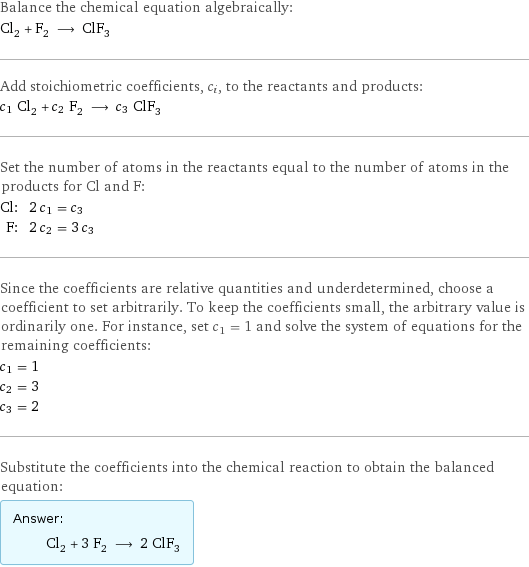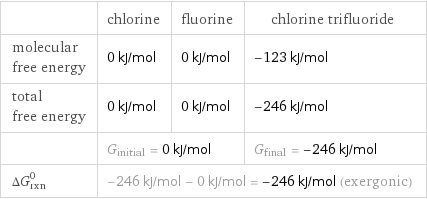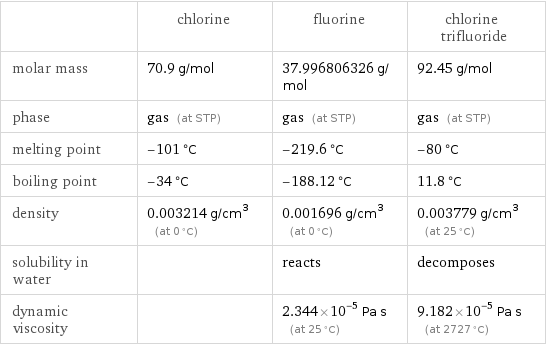Input interpretation

Cl_2 chlorine + F_2 fluorine ⟶ ClF_3 chlorine trifluoride
Balanced equation

Balance the chemical equation algebraically: Cl_2 + F_2 ⟶ ClF_3 Add stoichiometric coefficients, c_i, to the reactants and products: c_1 Cl_2 + c_2 F_2 ⟶ c_3 ClF_3 Set the number of atoms in the reactants equal to the number of atoms in the products for Cl and F: Cl: | 2 c_1 = c_3 F: | 2 c_2 = 3 c_3 Since the coefficients are relative quantities and underdetermined, choose a coefficient to set arbitrarily. To keep the coefficients small, the arbitrary value is ordinarily one. For instance, set c_1 = 1 and solve the system of equations for the remaining coefficients: c_1 = 1 c_2 = 3 c_3 = 2 Substitute the coefficients into the chemical reaction to obtain the balanced equation: Answer: | | Cl_2 + 3 F_2 ⟶ 2 ClF_3
Structures

+ ⟶
Names

chlorine + fluorine ⟶ chlorine trifluoride
Reaction thermodynamics
Gibbs free energy

| chlorine | fluorine | chlorine trifluoride molecular free energy | 0 kJ/mol | 0 kJ/mol | -123 kJ/mol total free energy | 0 kJ/mol | 0 kJ/mol | -246 kJ/mol | G_initial = 0 kJ/mol | | G_final = -246 kJ/mol ΔG_rxn^0 | -246 kJ/mol - 0 kJ/mol = -246 kJ/mol (exergonic) | |
Equilibrium constant
![Construct the equilibrium constant, K, expression for: Cl_2 + F_2 ⟶ ClF_3 Plan: • Balance the chemical equation. • Determine the stoichiometric numbers. • Assemble the activity expression for each chemical species. • Use the activity expressions to build the equilibrium constant expression. Write the balanced chemical equation: Cl_2 + 3 F_2 ⟶ 2 ClF_3 Assign stoichiometric numbers, ν_i, using the stoichiometric coefficients, c_i, from the balanced chemical equation in the following manner: ν_i = -c_i for reactants and ν_i = c_i for products: chemical species | c_i | ν_i Cl_2 | 1 | -1 F_2 | 3 | -3 ClF_3 | 2 | 2 Assemble the activity expressions accounting for the state of matter and ν_i: chemical species | c_i | ν_i | activity expression Cl_2 | 1 | -1 | ([Cl2])^(-1) F_2 | 3 | -3 | ([F2])^(-3) ClF_3 | 2 | 2 | ([ClF3])^2 The equilibrium constant symbol in the concentration basis is: K_c Mulitply the activity expressions to arrive at the K_c expression: Answer: | | K_c = ([Cl2])^(-1) ([F2])^(-3) ([ClF3])^2 = ([ClF3])^2/([Cl2] ([F2])^3)](../image_source/04b40ebe3c90b887666b4973d0d13d12.png)
Construct the equilibrium constant, K, expression for: Cl_2 + F_2 ⟶ ClF_3 Plan: • Balance the chemical equation. • Determine the stoichiometric numbers. • Assemble the activity expression for each chemical species. • Use the activity expressions to build the equilibrium constant expression. Write the balanced chemical equation: Cl_2 + 3 F_2 ⟶ 2 ClF_3 Assign stoichiometric numbers, ν_i, using the stoichiometric coefficients, c_i, from the balanced chemical equation in the following manner: ν_i = -c_i for reactants and ν_i = c_i for products: chemical species | c_i | ν_i Cl_2 | 1 | -1 F_2 | 3 | -3 ClF_3 | 2 | 2 Assemble the activity expressions accounting for the state of matter and ν_i: chemical species | c_i | ν_i | activity expression Cl_2 | 1 | -1 | ([Cl2])^(-1) F_2 | 3 | -3 | ([F2])^(-3) ClF_3 | 2 | 2 | ([ClF3])^2 The equilibrium constant symbol in the concentration basis is: K_c Mulitply the activity expressions to arrive at the K_c expression: Answer: | | K_c = ([Cl2])^(-1) ([F2])^(-3) ([ClF3])^2 = ([ClF3])^2/([Cl2] ([F2])^3)
Rate of reaction
![Construct the rate of reaction expression for: Cl_2 + F_2 ⟶ ClF_3 Plan: • Balance the chemical equation. • Determine the stoichiometric numbers. • Assemble the rate term for each chemical species. • Write the rate of reaction expression. Write the balanced chemical equation: Cl_2 + 3 F_2 ⟶ 2 ClF_3 Assign stoichiometric numbers, ν_i, using the stoichiometric coefficients, c_i, from the balanced chemical equation in the following manner: ν_i = -c_i for reactants and ν_i = c_i for products: chemical species | c_i | ν_i Cl_2 | 1 | -1 F_2 | 3 | -3 ClF_3 | 2 | 2 The rate term for each chemical species, B_i, is 1/ν_i(Δ[B_i])/(Δt) where [B_i] is the amount concentration and t is time: chemical species | c_i | ν_i | rate term Cl_2 | 1 | -1 | -(Δ[Cl2])/(Δt) F_2 | 3 | -3 | -1/3 (Δ[F2])/(Δt) ClF_3 | 2 | 2 | 1/2 (Δ[ClF3])/(Δt) (for infinitesimal rate of change, replace Δ with d) Set the rate terms equal to each other to arrive at the rate expression: Answer: | | rate = -(Δ[Cl2])/(Δt) = -1/3 (Δ[F2])/(Δt) = 1/2 (Δ[ClF3])/(Δt) (assuming constant volume and no accumulation of intermediates or side products)](../image_source/4283bf3f6dd14a22afe501c746b50700.png)
Construct the rate of reaction expression for: Cl_2 + F_2 ⟶ ClF_3 Plan: • Balance the chemical equation. • Determine the stoichiometric numbers. • Assemble the rate term for each chemical species. • Write the rate of reaction expression. Write the balanced chemical equation: Cl_2 + 3 F_2 ⟶ 2 ClF_3 Assign stoichiometric numbers, ν_i, using the stoichiometric coefficients, c_i, from the balanced chemical equation in the following manner: ν_i = -c_i for reactants and ν_i = c_i for products: chemical species | c_i | ν_i Cl_2 | 1 | -1 F_2 | 3 | -3 ClF_3 | 2 | 2 The rate term for each chemical species, B_i, is 1/ν_i(Δ[B_i])/(Δt) where [B_i] is the amount concentration and t is time: chemical species | c_i | ν_i | rate term Cl_2 | 1 | -1 | -(Δ[Cl2])/(Δt) F_2 | 3 | -3 | -1/3 (Δ[F2])/(Δt) ClF_3 | 2 | 2 | 1/2 (Δ[ClF3])/(Δt) (for infinitesimal rate of change, replace Δ with d) Set the rate terms equal to each other to arrive at the rate expression: Answer: | | rate = -(Δ[Cl2])/(Δt) = -1/3 (Δ[F2])/(Δt) = 1/2 (Δ[ClF3])/(Δt) (assuming constant volume and no accumulation of intermediates or side products)
Chemical names and formulas

| chlorine | fluorine | chlorine trifluoride formula | Cl_2 | F_2 | ClF_3 name | chlorine | fluorine | chlorine trifluoride IUPAC name | molecular chlorine | molecular fluorine |
Substance properties

| chlorine | fluorine | chlorine trifluoride molar mass | 70.9 g/mol | 37.996806326 g/mol | 92.45 g/mol phase | gas (at STP) | gas (at STP) | gas (at STP) melting point | -101 °C | -219.6 °C | -80 °C boiling point | -34 °C | -188.12 °C | 11.8 °C density | 0.003214 g/cm^3 (at 0 °C) | 0.001696 g/cm^3 (at 0 °C) | 0.003779 g/cm^3 (at 25 °C) solubility in water | | reacts | decomposes dynamic viscosity | | 2.344×10^-5 Pa s (at 25 °C) | 9.182×10^-5 Pa s (at 2727 °C)
Units
